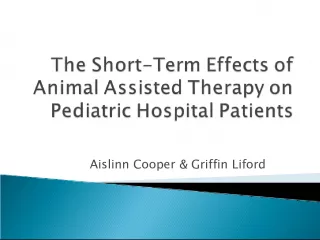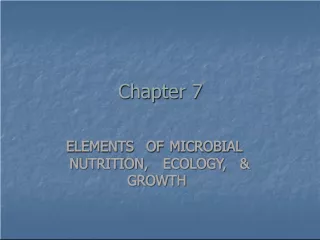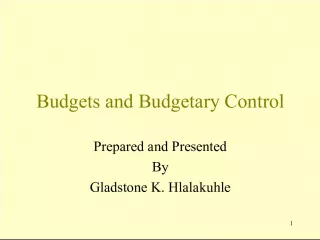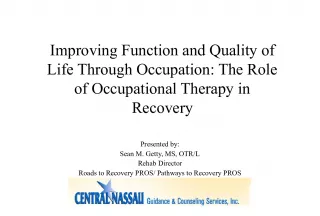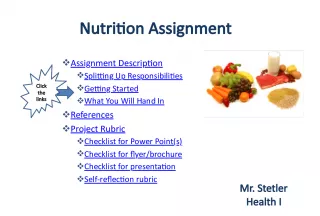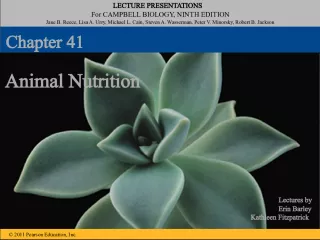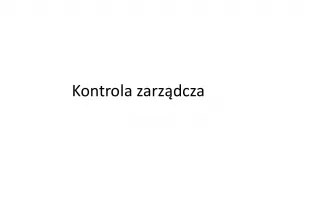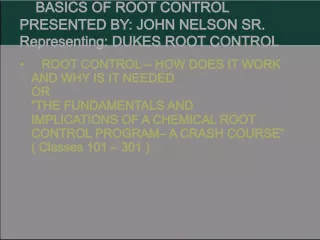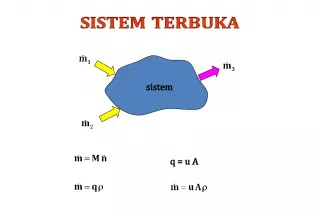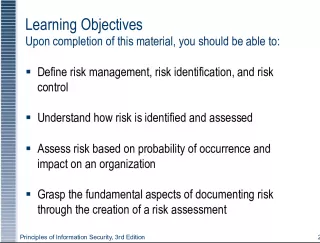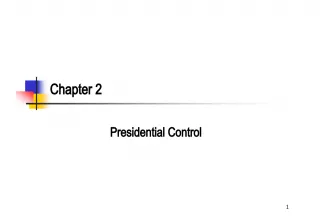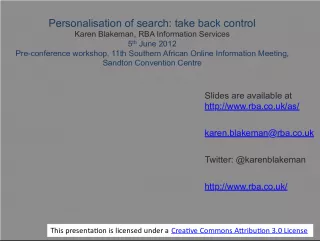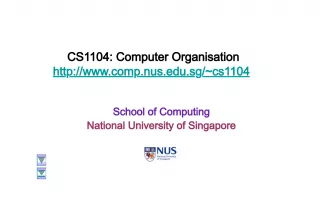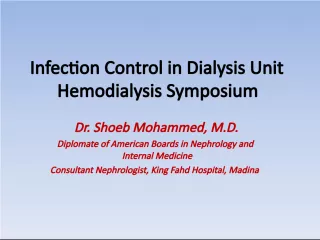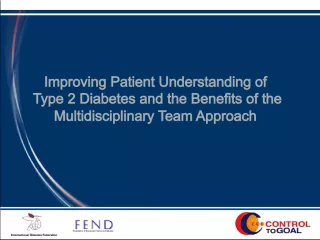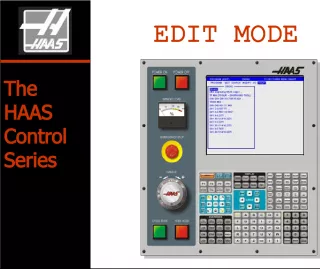Inpatient Glycemic Control and Nutrition Therapy
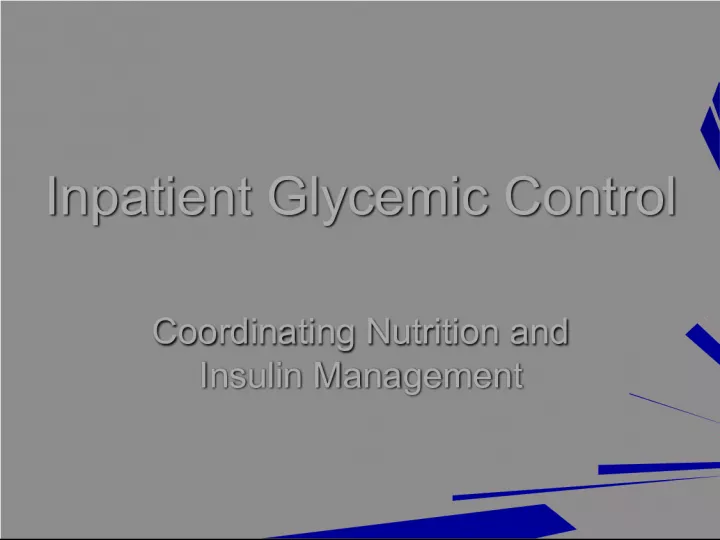

Coordinating nutrition and insulin management, standardization of carbohydrate intake at meals, and appropriate nutritional assessment guide our efforts in managing blood sugar levels for hospitalized patients.
- Uploaded on | 11 Views
-
 juanablanco
juanablanco
About Inpatient Glycemic Control and Nutrition Therapy
PowerPoint presentation about 'Inpatient Glycemic Control and Nutrition Therapy'. This presentation describes the topic on Coordinating nutrition and insulin management, standardization of carbohydrate intake at meals, and appropriate nutritional assessment guide our efforts in managing blood sugar levels for hospitalized patients.. The key topics included in this slideshow are . Download this presentation absolutely free.
Presentation Transcript
1. Inpatient Glycemic Control Inpatient Glycemic Control Coordinating Nutrition and Insulin Management Coordinating Nutrition and Insulin Management
3. What is Guiding our Nutrition Therapy What is Guiding our Nutrition Therapy Need for standardized Carbohydrate intake at meal Need for standardized Carbohydrate intake at meal Knowledge of carbohydrate content of Tube feedings Knowledge of carbohydrate content of Tube feedings Managing carbohydrate infusion via TPN Managing carbohydrate infusion via TPN All of the above to be based on an appropriate nutritional assessment All of the above to be based on an appropriate nutritional assessment
4. Research Studies Research Studies Rush University Guidelines, Nov.2006 Rush University Guidelines, Nov.2006 – The Diabetes Educator 32(6):954-962. Nov/Dec 2006. – The Diabetes Educator 32(6):954-962. Nov/Dec 2006. ASPEN Nutrition Support Practice Manual ASPEN Nutrition Support Practice Manual – 2 nd edition, 2005. – 2 nd edition, 2005. McMahon M McMahon M – Mayo Clinic – Mayo Clinic – Nutrition in Clinical Practice 19:120-128. April 2004. – Nutrition in Clinical Practice 19:120-128. April 2004.
5. Research Research Grainger A, Eiden K, Kemper J, Reeds D Grainger A, Eiden K, Kemper J, Reeds D – Nutrition in Clinical Practice 22:545-552. Oct 2007. – Nutrition in Clinical Practice 22:545-552. Oct 2007. Clement S et al: 2004 Clement S et al: 2004 – Diabetes Care 27:553-591. Feb 2004. – Diabetes Care 27:553-591. Feb 2004. Leahy J. Leahy J. – Endocrine Practice, 12(13):86-90. July/August 2006. – Endocrine Practice, 12(13):86-90. July/August 2006. – ACE/ADA Inpatient Diabetes and Glycemic Control Consensus Conference – ACE/ADA Inpatient Diabetes and Glycemic Control Consensus Conference
6. BASAL NUTRITIONAL SUPPLEMENTAL ILLNESS-RELATED Physiologic Insulin needs Physiologic Insulin needs
7. Insulin Requirements in Health and Illness Insulin Requirements in Health and Illness Copyright © 2004 American Diabetes Association. From Clement S, et al. Diabetes Care. 2004;27:553–591 . Reprinted with permission. Units Healthy Sick/Eating Sick/NPO Correction Nutritional Prandial Basal
8. MMC’s Diabetic Diets MMC’s Diabetic Diets 45-59 gm CHO/meal (1200-1500 kcal) 45-59 gm CHO/meal (1200-1500 kcal) 60-74 gm CHO/meal (1500-1800 kcal) 60-74 gm CHO/meal (1500-1800 kcal) – Meets nutrient needs for most patient populations. – Meets nutrient needs for most patient populations. 75-90 gm CHO/meal (1800-2200 kcal) 75-90 gm CHO/meal (1800-2200 kcal) 100 gm CHO/meal (2400 kcal) 100 gm CHO/meal (2400 kcal)
9. Meal Consumption on CHO Fresh Start Diet (60-74g/meal) Meal Consumption on CHO Fresh Start Diet (60-74g/meal) Meal Period Meal Period # of Patients # of Patients Avg # of gms of CHO selected for meal period Avg # of gms of CHO selected for meal period Avg # of gms of CHO consumed for meal period Avg # of gms of CHO consumed for meal period Breakfast Breakfast 82 82 68 68 50 50 (73%) (73%) Lunch Lunch 95 95 64 64 40 40 (62%) (62%) Dinner Dinner 78 78 71 71 50 50 (68%) (68%) Totals Totals 255 meals 255 meals 68 gms CHO 68 gms CHO 47 gms CHO 47 gms CHO (67%) (67%) MMC Aug 6,2008-Sept 5, 2008
10. Elements of Carbohydrate (CHO) Counting for RN Education Elements of Carbohydrate (CHO) Counting for RN Education Carbohydrate foods raise blood sugars w/in 15 minutes of food intake Carbohydrate foods raise blood sugars w/in 15 minutes of food intake Converted to glucose w/in 2-4 Hrs Converted to glucose w/in 2-4 Hrs Count only foods with carbohydrate from meals Count only foods with carbohydrate from meals – Grams of CHO per food will be provided on tray ticket – Grams of CHO per food will be provided on tray ticket – Floor stock Reference list available in unit kitchen – Floor stock Reference list available in unit kitchen
11. Portion Control Portion Control Over 150 recipes were analyzed for Carbohydrate content Over 150 recipes were analyzed for Carbohydrate content Serving portions for all these recipes were weighed and serving sizes were standardized for each recipe Serving portions for all these recipes were weighed and serving sizes were standardized for each recipe Education sessions with all the cooks and food servers were given to control portion size Education sessions with all the cooks and food servers were given to control portion size
13. Menu Selection Menu Selection Palm Pilot (programmed to include CHO’s) Palm Pilot (programmed to include CHO’s) Education to our Nutrition Care Representatives for Carbohydrate Counting Education to our Nutrition Care Representatives for Carbohydrate Counting Serves to educate patient while choosing meals Serves to educate patient while choosing meals
14. Nursing Education Nursing Education Collaborative approach with Nursing Diabetes Specialists Collaborative approach with Nursing Diabetes Specialists 3 Hour classes (2-4 classes/week) 3 Hour classes (2-4 classes/week) – Includes 1 hr of nutrition protocols that include the “how to” of carbohydrate counting as well as tube feeding and TPN guidelines – Includes 1 hr of nutrition protocols that include the “how to” of carbohydrate counting as well as tube feeding and TPN guidelines Traveling Glycemic Fair Traveling Glycemic Fair – Set up on individual clinical units and some units have made this mandatory – Set up on individual clinical units and some units have made this mandatory
15. Carbohydrate Content of Tube Feeding Formulas Carbohydrate Content of Tube Feeding Formulas Nepro Nepro – 167g CHO / L 2 Cal HN 2 Cal HN – 219g CHO / L Peptamen AF Peptamen AF – 107g CHO / L Peptamen 1.5 Peptamen 1.5 – 188g CHO / L Jevity 1.2 Jevity 1.2 – 169g CHO / L – 169g CHO / L Promote Promote – 130g CHO / L – 130g CHO / L Ensure Plus Ensure Plus – 211g CHO / L – 211g CHO / L Osmolite Osmolite – 144g CHO / L – 144g CHO / L This information is now included in all tube feed orders
16. Enteral Tube Feedings Considerations/Questions Enteral Tube Feedings Considerations/Questions Glycemic control can be difficult Glycemic control can be difficult – Varying tolerance – Varying tolerance – Unplanned discontinuation of feeds – Unplanned discontinuation of feeds Limited literature (Clement 2004, Grainger 2007) Limited literature (Clement 2004, Grainger 2007) When to start insulin therapy When to start insulin therapy Variety of feeding schedules Variety of feeding schedules – Bolus vs Continuous with or without oral diet – Bolus vs Continuous with or without oral diet What are the target glucose ranges What are the target glucose ranges
17. Literature Review Literature Review Grainger in NCP: 2007 Grainger in NCP: 2007 Pilot study using a glargine and lispro schedule during tube feedings Pilot study using a glargine and lispro schedule during tube feedings – 52 CICU type 2 DM patients (18-99 yo) – 52 CICU type 2 DM patients (18-99 yo) – Control group (N=24) retrospectively studied for mean glucose control – Control group (N=24) retrospectively studied for mean glucose control – Study group (N=28) were placed on an insulin protocol – Study group (N=28) were placed on an insulin protocol
18. Grainger Study (cont) Grainger Study (cont) Criteria Criteria Retrospective Data Retrospective Data Insulin Protocol Data Insulin Protocol Data Number of Patients Number of Patients Male/Female Male/Female 24 24 13/11 13/11 28 28 15/13 15/13 Age Age 69 + 10 69 + 10 66 + 13 66 + 13 BMI BMI 28 + 7 28 + 7 30 + 10 30 + 10 Hours to BG 80-140 Hours to BG 80-140 60.2 60.2 21.5 21.5 Diagnosis Diagnosis AMI AMI Cardiac (non-MI) Cardiac (non-MI) Noncardiac Noncardiac 7 7 4 4 13 13 13 13 6 6 9 9
19. Glucose Management Protocol Glucose Management Protocol Glucose target: 80-140mg/dl Glucose target: 80-140mg/dl Bolus Tube Feeding Regimens (Q4H, 6 feeds) Bolus Tube Feeding Regimens (Q4H, 6 feeds) Known DM or FBS >200mg/dl on admit Known DM or FBS >200mg/dl on admit Only insulin therapy (no oral agents) Only insulin therapy (no oral agents) 2 Cal HN or Nepro 2 Cal HN or Nepro BMI <15 received 35KKD BMI <15 received 35KKD BMI 15-19 received 30KKD BMI 15-19 received 30KKD BMI 20-29 received 20KKD BMI 20-29 received 20KKD BMI 30-40 received 15KKD BMI 30-40 received 15KKD
20. Grainger Protocol (cont) Grainger Protocol (cont) Tube feeds initiated by day 3 Tube feeds initiated by day 3 Retrospective group received preprandial insulin per MD orders Retrospective group received preprandial insulin per MD orders Study group (glucose check before feeds) Study group (glucose check before feeds) – Fixed dose of glargine (not held if feeds held) – Fixed dose of glargine (not held if feeds held) BMI <30 got 10 units, BMI >30 got 20 units BMI <30 got 10 units, BMI >30 got 20 units – Variable doses of lispro (dosed pre-feed) – Variable doses of lispro (dosed pre-feed) BMI <30 got 1 unit for each 15g of CHO in feeds BMI <30 got 1 unit for each 15g of CHO in feeds BMI > 30 got 1 unit for each 10g of CHO in feeds BMI > 30 got 1 unit for each 10g of CHO in feeds Correctional if BG >140mg/dl Correctional if BG >140mg/dl
21. Sliding Scale Lispro Sliding Scale Lispro If glucose < 100 give Lispro after tube feed started If glucose < 100 give Lispro after tube feed started If glucose >100 give lispro at start of feeds If glucose >100 give lispro at start of feeds Correctional “Sliding Scale” Lispro was weight based and given with the nutritional dose of Lispro Correctional “Sliding Scale” Lispro was weight based and given with the nutritional dose of Lispro Lispro dose increased by 3 units if 2 consecutive glucoses were >200mg/dl Lispro dose increased by 3 units if 2 consecutive glucoses were >200mg/dl
22. Grainger: Glucose Control Grainger: Glucose Control Blood Glucose Blood Glucose Retrospective Retrospective Protocol Protocol P value P value Mean BG Mean BG 225.1 225.1 148.9 148.9 <.0001 <.0001 < 79mg/dl < 79mg/dl 12(1.7%) 12(1.7%) 49(4.14%) 49(4.14%) 1% <65mg/dl 1% <65mg/dl .02 .02 80-140 mg/dl 80-140 mg/dl 58(8.3%) 58(8.3%) 576(48.6%) 576(48.6%) .01 .01 > 141 > 141 632(90%) 632(90%) 559(47.2%) 559(47.2%) <.0001 <.0001
23. Conclusions Conclusions A SQ insulin protocol reduced average blood glucoses by approx 80mg/dl A SQ insulin protocol reduced average blood glucoses by approx 80mg/dl Tighter control resulted in a modest increase in hypoglycemia (with no adverse events found) Tighter control resulted in a modest increase in hypoglycemia (with no adverse events found) Further studies are needed to determine if adjustments in lispro baseline could lead to tighter control Further studies are needed to determine if adjustments in lispro baseline could lead to tighter control
24. Observation Letter: Glargine and Continuous Tube Feeds Observation Letter: Glargine and Continuous Tube Feeds Diabetes Care 2002 (25:1889-1890) Diabetes Care 2002 (25:1889-1890) 60 yo male with type 2 DM with squamous ca of oral cavity with recurrent aspiration 60 yo male with type 2 DM with squamous ca of oral cavity with recurrent aspiration – HbA1c 7.5% – HbA1c 7.5% Continuous feeds started with glargine @HS Continuous feeds started with glargine @HS Glargine dose was increased gradually by 2-4units at 3 day intervals to attain BG of 100-140mg/dl Glargine dose was increased gradually by 2-4units at 3 day intervals to attain BG of 100-140mg/dl Good control was achieved with 45units glargine with no hypoglycemia Good control was achieved with 45units glargine with no hypoglycemia After 6 months patient’s HbA1c was 6.1% After 6 months patient’s HbA1c was 6.1%
25. Additional Considerations for Enteral Tube Feedings Additional Considerations for Enteral Tube Feedings Avoid increasing tube feeding delivery until adequate BG control is achieved Avoid increasing tube feeding delivery until adequate BG control is achieved Basal insulin generally no more than 40% of daily insulin to avoid hypoglycemia Basal insulin generally no more than 40% of daily insulin to avoid hypoglycemia Nutritional insulin to be given as programmed doses of regular or rapid acting insulin Nutritional insulin to be given as programmed doses of regular or rapid acting insulin NPH insulin’s profile better fits a nocturnal feeding schedule (peaking at 6-8 hrs) NPH insulin’s profile better fits a nocturnal feeding schedule (peaking at 6-8 hrs) If tube feeds are unexpectedly stopped start a D10% IV at same rate of feeds to avoid hypoglycemia and increase glucose checks If tube feeds are unexpectedly stopped start a D10% IV at same rate of feeds to avoid hypoglycemia and increase glucose checks Avoid high fat formulas (gastroparesis) Avoid high fat formulas (gastroparesis)
26. Glucose Management with Parenteral Nutrition Glucose Management with Parenteral Nutrition ASPEN Guidelines: ASPEN Guidelines: – Check glucoses Q6hrs on TPN – Check glucoses Q6hrs on TPN – Only Regular insulin is compatible w/ TPN – Only Regular insulin is compatible w/ TPN – Limit initial dextrose in TPN solution for patients with hyperglycemia to 150-200g/day – Limit initial dextrose in TPN solution for patients with hyperglycemia to 150-200g/day – Do not increase dextrose calories via TPN until glucoses are consistently <180mg/dl – Do not increase dextrose calories via TPN until glucoses are consistently <180mg/dl – 5-15% of insulin in TPN adheres to the tubing therefore insulin requirements may appear high – 5-15% of insulin in TPN adheres to the tubing therefore insulin requirements may appear high
27. Glucose Control and TPN M McMahon MD Glucose Control and TPN M McMahon MD Measure glucose before TPN and 2 to 4 times daily after start of TPN Measure glucose before TPN and 2 to 4 times daily after start of TPN Avoid overfeeding calories in TPN patients (importance of Nutritional Assessment) Avoid overfeeding calories in TPN patients (importance of Nutritional Assessment) Majority of DM patients will require supplemental insulin Majority of DM patients will require supplemental insulin – Start TPN with 0.1 unit of insulin per g of Dextrose, (this ratio should not result in hypoglycemia) – Start TPN with 0.1 unit of insulin per g of Dextrose, (this ratio should not result in hypoglycemia) – If glucoses remain above target increase insulin in TPN by 0.05 units per g of Dextrose to 0.2 units/g of dextrose (ASPEN allows up to 0.3units/g of dextrose) – If glucoses remain above target increase insulin in TPN by 0.05 units per g of Dextrose to 0.2 units/g of dextrose (ASPEN allows up to 0.3units/g of dextrose)
28. McMahon (cont) McMahon (cont) Do not increase dextrose in TPN until target glucoses are met for previous 24hrs Do not increase dextrose in TPN until target glucoses are met for previous 24hrs Increase insulin proportional to Dextrose once the appropriate ratio is attained Increase insulin proportional to Dextrose once the appropriate ratio is attained Hypoglycemia after discontinuation of TPN should not occur unless given excess dextrose Hypoglycemia after discontinuation of TPN should not occur unless given excess dextrose
29. MMC TPN Ordering MMC TPN Ordering TPN is ordered in grams of protein, dextrose and lipids for 24 hrs per nutrition assessment TPN is ordered in grams of protein, dextrose and lipids for 24 hrs per nutrition assessment – Ex: 80g of aminosyn, 200g of Dextrose and 50g of Liposyn for 45% carbohydrate calories – Ex: 80g of aminosyn, 200g of Dextrose and 50g of Liposyn for 45% carbohydrate calories Insulin is ordered as units per day vs liter Insulin is ordered as units per day vs liter Electrolytes and minerals are ordered per liter Electrolytes and minerals are ordered per liter – Ex: NaCl 50 mEq/L – Ex: NaCl 50 mEq/L
30. Collaborative Review Collaborative Review Literature Review Literature Review Other Hospital Programs Other Hospital Programs Open Discussions Open Discussions MD, RD, RN and RPh developed Protocols
31. MMC Insulin Protocols MMC Insulin Protocols Nutrition Component Nutrition Component
32. Nutritional Insulin Nutritional Insulin Types nutritional insulin Types nutritional insulin Action Action Timing Timing Novolog ® (aspart) MMC Novolog ® (aspart) MMC Rapid Acting Insulin Rapid Acting Insulin Onset: 0-15 minutes Onset: 0-15 minutes Peak: 1-2 hours Peak: 1-2 hours Duration: 3-4 hours Duration: 3-4 hours **Within 15 minutes **Within 15 minutes of meal of meal Regular Human Insulin Regular Human Insulin Short Acting Short Acting Onset: 30-60 minutes Onset: 30-60 minutes Peak: 90 min-2 hours Peak: 90 min-2 hours Duration: 6-8 hours Duration: 6-8 hours 30 minutes ac meal 30 minutes ac meal NPH NPH Intermediate Acting Intermediate Acting Onset: 2-4 hours Onset: 2-4 hours Peak: 4-10 hours Peak: 4-10 hours Duration: 10-16 hours Duration: 10-16 hours Start of Tube feeding Start of Tube feeding
33. Insulin Profiles Insulin Profiles
34. MMC’s Diabetic Diets MMC’s Diabetic Diets 45-59 gm CHO/meal (1200-1500 kcal) 45-59 gm CHO/meal (1200-1500 kcal) 60-74 gm CHO/meal (1500-1800 kcal) 60-74 gm CHO/meal (1500-1800 kcal) – Meets nutrient needs for most patient populations. – Meets nutrient needs for most patient populations. 75-90 gm CHO/meal (1800-2200 kcal) 75-90 gm CHO/meal (1800-2200 kcal) 100 gm CHO/meal (2400 kcal) 100 gm CHO/meal (2400 kcal)
35. Prandial /Nutritional Insulin Dosing Oral Diet Prandial /Nutritional Insulin Dosing Oral Diet Dosing will be pre-selected based on: Dosing will be pre-selected based on: – Patient’s BMI & meal plan requirement – Patient’s BMI & meal plan requirement – Percent of CHO consumed from meals . – Percent of CHO consumed from meals . Questioning food consumption, give prandial dose at end of the meal. Questioning food consumption, give prandial dose at end of the meal. If pre meal BG>150= nutritional + correctional scale ac meal. If pre meal BG>150= nutritional + correctional scale ac meal. If pre-meal BG 70-110 mg/d, give meal coverage pc meal If pre-meal BG 70-110 mg/d, give meal coverage pc meal Insulin may be given up to 30 minutes AFTER the patient eats Insulin may be given up to 30 minutes AFTER the patient eats HOLD nutritional dose insulin if patient is NPO HOLD nutritional dose insulin if patient is NPO
36. SC Protocol Prandial or Nutritional insulin coverage SC Protocol Prandial or Nutritional insulin coverage 62 yo T1DM s/p RBKA 62 yo T1DM s/p RBKA Diet: Diet: – Diabetic, 60-74 gm CHO/meal – Diabetic, 60-74 gm CHO/meal Scheduled Prandial Insulin dose per BMI + meal plan: Scheduled Prandial Insulin dose per BMI + meal plan: – 6 units ac meals – 6 units ac meals ac BG at 1150: ac BG at 1150: – 301mg/dl – 301mg/dl Pt sad, verbalizes “stomach upset, not very hungry” Pt sad, verbalizes “stomach upset, not very hungry” Lunch tray arrives. Plan for patient? Lunch tray arrives. Plan for patient?
37. SC Protocol Example Plan SC Protocol Example Plan Hold pre-meal insulin dose Hold pre-meal insulin dose Partnership Partnership – Nurse – Nurse – CNA – CNA – Patient – Patient – Family – Family Review meal ticket carbohydrate amount Review meal ticket carbohydrate amount Review carbohydrate consumed from plate Review carbohydrate consumed from plate Check tray ticket for total CHO gm reference vs % amt eaten Check tray ticket for total CHO gm reference vs % amt eaten
38. SC Protocol Example SC Protocol Example Example: total gm CHO on tray: 60 gm Example: total gm CHO on tray: 60 gm – If >75% total gm CHO on tray consumed: give full dose (>45gm) – If >75% total gm CHO on tray consumed: give full dose (>45gm) – If 25-74% total gm CHO on tray consumed: give 3 units (15-45 gm) – If 25-74% total gm CHO on tray consumed: give 3 units (15-45 gm) – If <25% total gm CHO on tray eaten consumed: no insulin coverage ( <15 gm) – If <25% total gm CHO on tray eaten consumed: no insulin coverage ( <15 gm)
39. Insulin Orders Insulin Orders **Nutritional** **Nutritional** Insulin Aspart, SC, 6.0 daily with lunch Insulin Aspart, SC, 6.0 daily with lunch Based on 60-74 CHO meal Based on 60-74 CHO meal 6.0 units if full Meal-% of Carbs Eaten 75-100 6.0 units if full Meal-% of Carbs Eaten 75-100 3.0 units if half Meal-% of Carbs Eaten 25-74 3.0 units if half Meal-% of Carbs Eaten 25-74 0 units if NO meal-% of Carbs Eaten 0-24 0 units if NO meal-% of Carbs Eaten 0-24 *Correctional Coverage* *Correctional Coverage* Insulin Aspart, SC, tid-meals, Insulin Aspart, SC, tid-meals, PRN for BG level : PRN for BG level : 2 units if BG 151-200 2 units if BG 151-200 4 units if BG 201-250 4 units if BG 201-250 6 units if BG 251-300 6 units if BG 251-300 8 units if BG 301-350 8 units if BG 301-350 10 units if BG 351-400 10 units if BG 351-400 • RN & patient agree 50% meal CHO consumed • RN & patient agree 50% meal CHO consumed • BG was 301 mg/dl ac • BG was 301 mg/dl ac What will your total insulin dose be? What will your total insulin dose be?
40. SC Protocol Example Plan SC Protocol Example Plan RN & patient agree 50% meal CHO consumed RN & patient agree 50% meal CHO consumed BG was 301 mg/dl ac BG was 301 mg/dl ac – Answer – Answer – What will your total insulin dose be? – What will your total insulin dose be? – Total dose = 11 units aspart post meal – Total dose = 11 units aspart post meal
41. Glycemic Management Glycemic Management Tube Feeding Insulin Protocols Tube Feeding Insulin Protocols
42. Enteral Nutrition/Tube feeding Enteral Nutrition/Tube feeding Continuous Continuous – Infusing over 24hrs – Infusing over 24hrs Bolus Bolus – Mimics meals – Mimics meals Nocturnal Nocturnal – Infusion at night: typically 12hr infusion – Infusion at night: typically 12hr infusion – Can be NPO or eating during day – Can be NPO or eating during day – Usually transitioning stage – Usually transitioning stage
43. Basal, Nutritional, Correctional Enteral Tube Feeding Basal, Nutritional, Correctional Enteral Tube Feeding Need 3 components of insulin Need 3 components of insulin Basal insulin Pre-existing DM/hyperglycemia: Basal insulin Pre-existing DM/hyperglycemia: Continue the basal insulin dose (glargine/detemir) Continue the basal insulin dose (glargine/detemir) – If patient has not been treated with basal insulin + has Random BG >200: – If patient has not been treated with basal insulin + has Random BG >200: MD can initiate basal dose of glargine on weight/BMI MD can initiate basal dose of glargine on weight/BMI (Consider adjust basal if reached Prandial Insulin threshold + BG remains over 150mg/dl) (Consider adjust basal if reached Prandial Insulin threshold + BG remains over 150mg/dl) Nutritional to cover CHO in TF Nutritional to cover CHO in TF – Type of insulin + dosage dependent on: – Type of insulin + dosage dependent on: Glucose levels Glucose levels TF schedule TF schedule BMI BMI TF formula/rate TF formula/rate Correctional to cover high BG q 6 hours Correctional to cover high BG q 6 hours Regular Insulin Regular Insulin
44. Continuous ETF Continuous ETF Glucose Monitoring: Glucose Monitoring: – Check BG q 6 hours all ETF patients – Check BG q 6 hours all ETF patients – Goal glucose during feeding: 90-150 for standard pt – Goal glucose during feeding: 90-150 for standard pt – If BG levels < 150mg/dl x 24h, + tolerating at goal rate: – If BG levels < 150mg/dl x 24h, + tolerating at goal rate: ▪↓ BG testing q 12 hours ▪↓ BG testing q 12 hours – If TF CHO content ↑ (i.e. increasing rate, changing formula) – If TF CHO content ↑ (i.e. increasing rate, changing formula) Continue q 6 hour BG checks Continue q 6 hour BG checks Prandial coverage : Prandial coverage : – Scheduled: Regular insulin q6h – Scheduled: Regular insulin q6h – Dose Based on BMI/CHO infusion – Dose Based on BMI/CHO infusion Correctional Correctional – Regular insulin – Regular insulin
45. Dosing Dosing Regular Insulin q 6h: Regular Insulin q 6h: – BMI <30: 1 unit per 15 gm CHO – BMI <30: 1 unit per 15 gm CHO – BMI >30: 1 unit per 10 gm CHO – BMI >30: 1 unit per 10 gm CHO Example: Example: – 1Cal Tube feeding (144 gm/L) @ 50 ml/hr: – 1Cal Tube feeding (144 gm/L) @ 50 ml/hr: 43.5 gm CHO infused q 6h 43.5 gm CHO infused q 6h BMI <30, 3 units Regular q 6h BMI <30, 3 units Regular q 6h BMI >30, 4 units Regular q 6h BMI >30, 4 units Regular q 6h
46. Continuous Enteral Tube Feeds- Example Continuous Enteral Tube Feeds- Example Correctional insulin is given if BG q 6 hours is elevated Correctional insulin is given if BG q 6 hours is elevated Example Example Patient on 1.2 Cal formula (169 gm CHO/L) continuous 70 ml/hr ETF Patient on 1.2 Cal formula (169 gm CHO/L) continuous 70 ml/hr ETF BMI > 30 (1 unit Regular Insulin per 10 gm CHO) BMI > 30 (1 unit Regular Insulin per 10 gm CHO) BG check at 0615 =217mg/dl BG check at 0615 =217mg/dl What is total dose of insulin you will give? What is total dose of insulin you will give? Total CHO q 6 h: 71 gm Total CHO q 6 h: 71 gm 11 units 11 units Orders: Orders: – Glargine 10 units q HS – Regular insulin 7 units q 6 hours with TF – Correction scale: IF BG >150 151-200 2 units R 201-250 4 units R 251-300 6 units R 301-350 8 units R >350mg 10 units R
47. Nocturnal ETF Nocturnal ETF NPH recommended for overnight ETF NPH recommended for overnight ETF – Intermediate acting insulin – Intermediate acting insulin – Time action best covers TF duration – Time action best covers TF duration 10-16 hrs 10-16 hrs – Dose based on weight/BMI – Dose based on weight/BMI BMI <30: 10 units NPH at onset of TF BMI <30: 10 units NPH at onset of TF BMI >30: 20 units NPH at onset of TF BMI >30: 20 units NPH at onset of TF – Give at start of nocturnal tube feeding – Give at start of nocturnal tube feeding Check BG q 6 hours Check BG q 6 hours
48. Basal , Nutritional, Correctional TF Considerations Basal , Nutritional, Correctional TF Considerations Trend of BG levels over 24 hours Trend of BG levels over 24 hours – if BG consistently exceed target range – if BG consistently exceed target range ↑ Regular ↑ Regular ↑ NPH for coverage of nocturnal TF ↑ NPH for coverage of nocturnal TF – Critically ill/SCU patients typically managed on Insulin Infusion – Critically ill/SCU patients typically managed on Insulin Infusion
49. TF Considerations Hypoglycemia TF Considerations Hypoglycemia Be aware of changes in clinical or nutritional status Be aware of changes in clinical or nutritional status – Metabolic needs may change as will insulin needs, Glucose monitoring is key. – Metabolic needs may change as will insulin needs, Glucose monitoring is key. If TF to be interrupted for > 1 hour: If TF to be interrupted for > 1 hour: – Start IV infusion of 10% dextrose at same rate as TF – Start IV infusion of 10% dextrose at same rate as TF – Continue until TF resumed at former rate – Continue until TF resumed at former rate – Interruptions, clogging, disconnections – Interruptions, clogging, disconnections Major concerns Major concerns
50. Inpatient Insulin Management Inpatient Insulin Management Parenteral Nutrition: Parenteral Nutrition: TPN insulin protocols TPN insulin protocols
51. Parenteral Nutrition Parenteral Nutrition Why need: Why need: – Dysfunctional GI tract – Dysfunctional GI tract – Oncology – Oncology Includes Dextrose (CHO source) for nutrition Includes Dextrose (CHO source) for nutrition Varies with individual Varies with individual Ordered Ordered – Grams of Dextrose per day or per bag – Grams of Dextrose per day or per bag
52. Insulin Management TPN Insulin Management TPN Patients with diabetes or significant hyperglycemia may need additional insulin coverage for dextrose in TPN Patients with diabetes or significant hyperglycemia may need additional insulin coverage for dextrose in TPN Check BG on all TPN patients Check BG on all TPN patients – Check BG every 6 hours – Check BG every 6 hours Guidelines= add 0.1 unit Regular per gram of dextrose Guidelines= add 0.1 unit Regular per gram of dextrose – Example: TPN 225 gram dextrose x 0.1units regular – Example: TPN 225 gram dextrose x 0.1units regular – = Add 22.5 units regular insulin to TPN bag – = Add 22.5 units regular insulin to TPN bag
53. TPN considerations TPN considerations Trend of BG levels over 24 hours Trend of BG levels over 24 hours – ↑ Regular if BG >150 for standard target: – ↑ Regular if BG >150 for standard target: Guidelines: Increase by 0.05 units Regular Insulin per gram Dextrose Guidelines: Increase by 0.05 units Regular Insulin per gram Dextrose Threshold: 0.3 units regular insulin/gm dextrose, bag/day Threshold: 0.3 units regular insulin/gm dextrose, bag/day If ↑ grams of nutritional dextrose If ↑ grams of nutritional dextrose – =↑ amount of Regular insulin with same insulin: gm dextrose ratio required to keep BG in target range – =↑ amount of Regular insulin with same insulin: gm dextrose ratio required to keep BG in target range SQ insulin or an infusion may be added if BG cont out of goal range + insulin:dextrose threshold reached SQ insulin or an infusion may be added if BG cont out of goal range + insulin:dextrose threshold reached
54. Thank You Thank You Questions? Questions?
